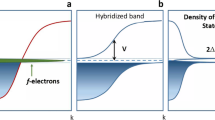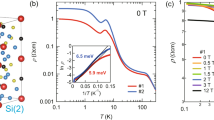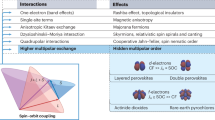Abstract
Many correlated electron materials, such as high-temperature superconductors1, geometrically frustrated oxides2 and low-dimensional magnets3,4, are still objects of fruitful study because of the unique properties that arise owing to poorly understood many-body effects. Heavy-fermion metals5—materials that have high effective electron masses due to those effects—represent a class of materials with exotic properties, ranging from unusual magnetism, unconventional superconductivity and ‘hidden’ order parameters6. The heavy-fermion superconductor URu2Si2 has held the attention of physicists for the past two decades owing to the presence of a ‘hidden-order’ phase below 17.5 K. Neutron scattering measurements indicate that the ordered moment is 0.03μB, much too small to account for the large heat-capacity anomaly at 17.5 K. We present recent neutron scattering experiments that unveil a new piece of this puzzle—the spin-excitation spectrum above 17.5 K exhibits well-correlated, itinerant-like spin excitations up to at least 10 meV, emanating from incommensurate wavevectors. The large entropy change associated with the presence of an energy gap in the excitations explains the reduction in the electronic specific heat through the transition.
This is a preview of subscription content, access via your institution
Access options
Subscribe to this journal
Receive 12 print issues and online access
$259.00 per year
only $21.58 per issue
Buy this article
- Purchase on SpringerLink
- Instant access to full article PDF
Prices may be subject to local taxes which are calculated during checkout





Similar content being viewed by others
References
Dagotto, E. Correlated electrons in high temperature superconductors. Rev. Mod. Phys. 66, 763–840 (1994).
Greedan, J. E. Geometrically frustrated materials. J. Mater. Chem. 11, 37–53 (2000).
Affleck, I. Quantum spin chains and the Haldane gap. J. Phys. Condens. Matter 1, 3047–3072 (1989).
Dagotto, E. & Rice, T. M. Surprises on the way from one- to two-dimensional quantum magnets: The ladder materials. Science 271, 618–623 (1996).
Fisk, Z. et al. Heavy-electron metals—new highly correlated states of matter. Science 239, 33–42 (1988).
Tripathi, V., Chandra, P. & Coleman, P. Itinerancy and hidden order in URu2Si2 . J. Phys. Condens. Matter 17, 5285–5311 (2005).
Silhanek, A. V. et al. Quantum critical 5f electrons avoid singularities in U(Ru,Rh)2Si2 . Phys. Rev. Lett. 95, 026403 (2005).
Mineev, V. P. & Samokhin, K. V. de Haas van Alphen effect in metals without an inversion center. Phys. Rev. B 72, 014432 (2005).
Chandra, P., Coleman, P., Mydosh, J. A. & Tripathi, V. Hidden orbital order in the heavy fermion metal URu2Si2 . Nature 417, 831–834 (2002).
Broholm, C. Magnetic excitations and ordering in the heavy-electron superconductor URu2Si2 . Phys. Rev. Lett. 58, 1467–1470 (1987).
Broholm, C. et al. Magnetic excitations in the heavy-fermion superconductor URu2Si2 . Phys. Rev. B 43, 12809–12822 (1991).
Squires, G. L. Introduction to the Theory of Neutron Scattering (Dover, New York, 1997).
Buyers, W. J. L. et al. Spin wave collapse and incommensurate fluctuations in URu2Si2 . Physica B 199, 95–97 (1994).
Fawcett, E. Spin-density-wave antiferromagnetism in chromium. Rev. Mod. Phys. 60, 209–283 (1988).
Bao, W., Broholm, C., Honig, J. M., Metcalf, P. & Trevino, S. F. Itinerant antiferromagnetism in the Mott compound V1.973O3 . Phys. Rev. B 54, R3726–R3729 (1996).
Wiebe, C. R., Luke, G. M., Yamani, Z., Menovsky, A. A. & Buyers, W. J. L. Search for hidden orbital currents and observation of an activated ring of magnetic scattering in the heavy fermion superconductor URu2Si2 . Phys. Rev. B 69, 132418 (2004).
Bonn, D. A., Garrett, J. D. & Timusk, T. Far-infrared properties of URu2Si2 . Phys. Rev. Lett. 61, 1305–1308 (1988).
Chou, H. et al. Neutron-scattering study of spin fluctuations in superconducting YBa2Cu3O6+x (x=0.40,0.45,0.50). Phys. Rev. B 43, 5554–5563 (1991).
Mason, T. E., Aeppli, G. & Mook, H. A. Magnetic dynamics of superconducting La1.86Sr0.14CuO4 . Phys. Rev. Lett. 68, 1414–1417 (1992).
Rossat-Mignod, J. et al. Inelastic neutron scattering study of the spin dynamics in the YBa2Cu3O6+x system. Physica B 192, 109–121 (1993).
Stock, C. et al. Dynamic stripes and resonance in the superconducting and normal phases of YBa2Ca3O6.5 ortho-II superconductor. Phys. Rev. B 69, 014502 (2004).
Behnia, K. et al. Thermal transport in the hidden-order state of URu2Si2 . Phys. Rev. Lett. 94, 156405 (2005).
Maple, M. B. et al. Partially gapped Fermi surface in the heavy-electron superconductor URu2Si2 . Phys. Rev. Lett. 56, 185–188 (1986).
Palstra, T. T. M. et al. Superconducting and magnetic transitions in the heavy-fermion system URu2Si2 . Phys. Rev. Lett. 55, 2727–2730 (1985).
Feynman, R. P. in Progress in Low Temperature Physics Vol. 1 (ed. Gorter, C.) (Interscience, New York, 1955).
Acknowledgements
The authors would like to acknowledge helpful discussions with C. Broholm, C. D. Batista, A. Leggett, C. M. Varma, J. S. Gardner, J. S. Brooks, G. S. Boebinger and B. D. Gaulin. This work was made possible by support through the NSF and the state of Florida. L.B. acknowledges support from the NHMFL in house research program and Y.J. acknowledges support from the NHMFL Schuller program. G.M.L., G.J.M. and W.J.L.B. acknowledge support through NSERC and the CIAR. The authors are grateful to the local support staff at the NIST Center for Neutron Research. Data analysis was completed with DAVE, which can be obtained at http://www.ncnr.nist.gov/dave/. The work at NIST is supported in part by the National Science Foundation under Agreement No. DMR-0454672. A portion of this work was performed at the National High Magnetic Field Laboratory, which is supported by NSF Cooperative Agreement No. DMR-0084173, by the State of Florida, and by the DOE.
Author information
Authors and Affiliations
Contributions
Scattering experiments were completed by C.R.W., J.A.J., G.J.M., H.D.Z., Y.Q., J.R.D.C., Z.Y. and W.J.L.B. The crystals were grown by J.D.G. and G.M.L. Specific heat measurements were made by Y.J.J. and L.B. Data analysis and writing of the paper was completed by C.R.W., J.A.J., G.J.M., G.M.L., L.B. and W.J.L.B.
Corresponding author
Ethics declarations
Competing interests
The authors declare no competing financial interests.
Rights and permissions
About this article
Cite this article
Wiebe, C., Janik, J., MacDougall, G. et al. Gapped itinerant spin excitations account for missing entropy in the hidden-order state of URu2Si2. Nature Phys 3, 96–99 (2007). https://doi.org/10.1038/nphys522
Received:
Accepted:
Published:
Issue date:
DOI: https://doi.org/10.1038/nphys522
This article is cited by
-
Electronic transport probes a hidden state
Nature Physics (2024)
-
A microscopic Kondo lattice model for the heavy fermion antiferromagnet CeIn3
Nature Communications (2023)
-
Intertwined dipolar and multipolar order in the triangular-lattice magnet TmMgGaO4
Nature Communications (2019)
-
Evidence for a nematic component to the hidden-order parameter in URu2Si2 from differential elastoresistance measurements
Nature Communications (2015)
-
Direct observation of lattice symmetry breaking at the hidden-order transition in URu2Si2
Nature Communications (2014)



